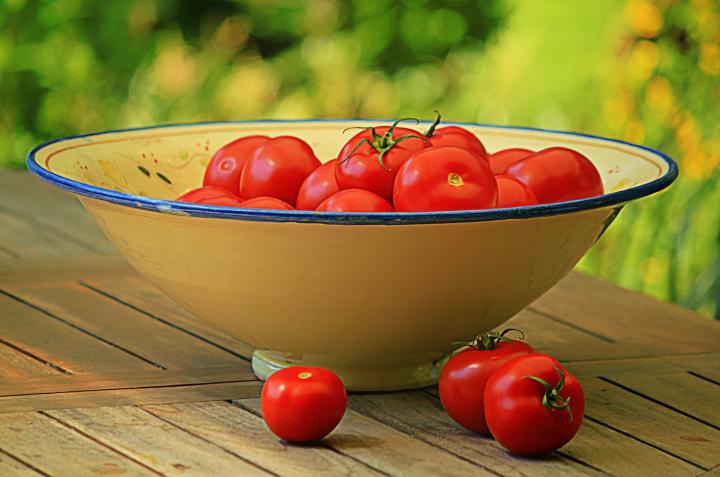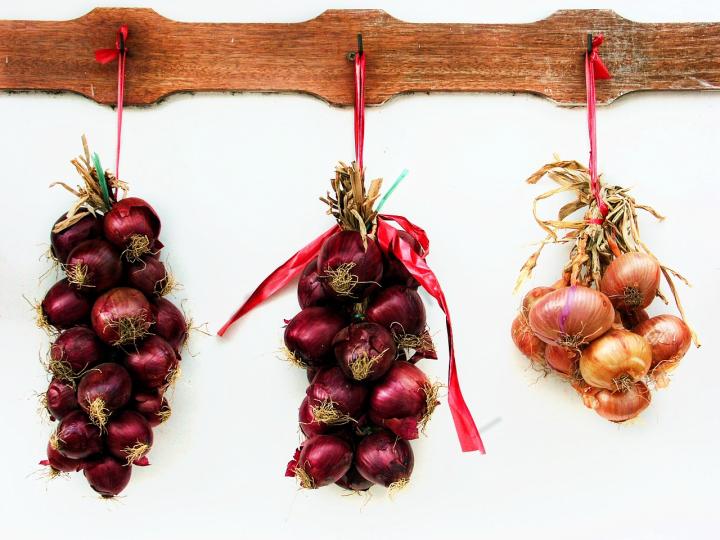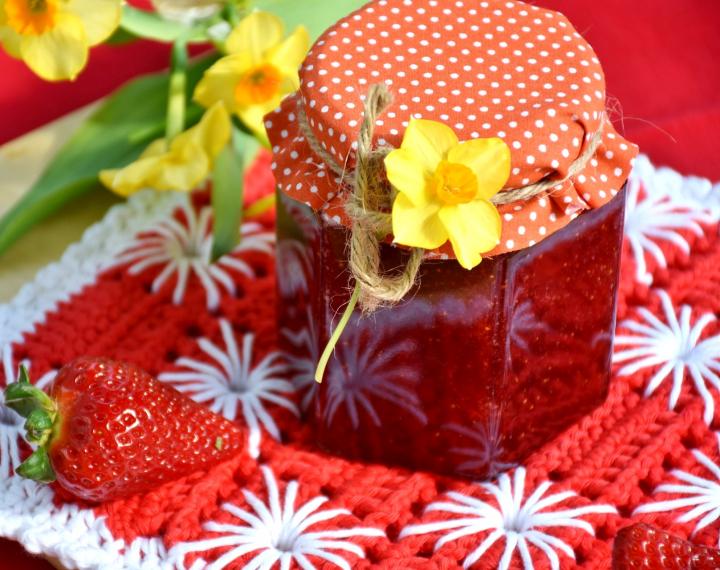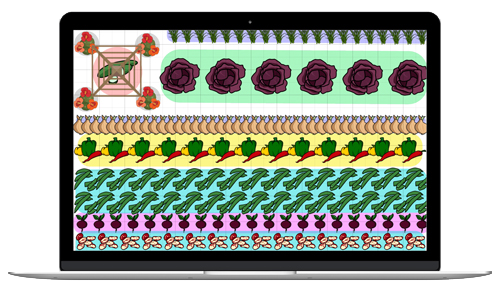Quick quiz: Do you store apples in the fridge? How about tomatoes? Where do you put your garlic? Check our list of vegetables and fruit to see how we store produce. Hint: The fridge is not always the answer!
List of Vegetables to Store in Refrigerator
- Asparagus: Store asparagus by placing the spears upright in an open container (such as a drinking glass or a jar) that contains about an inch of water. Cover the asparagus loosely with a produce bag. It should be kept for 10 to 14 days.
- Beans (snap: Keep snap beans such as green beans in a perforated produce bag in the refrigerator and they should keep for about a week. Note that their condition will deteriorate faster if they are kept below 40°F.
- Brussels sprouts: Store sprouts in a perforated plastic bag in the refrigerator for up to a month.
- Broccoli: Store broccoli in a perforated plastic bag in the refrigerator for up to 2 weeks. Do not wash it prior to putting it in the fridge, as this can encourage bacterial rot.
- Cabbage: Cabbage can be stored in the refrigerator in the produce drawer for up to 4 to 5 months.
- Cauliflower: As with broccoli, store cauliflower in a perforated plastic bag in the refrigerator. Do not wash it prior to storage; it should keep for 2 to 3 weeks.
- *Radishes: Radishes keep well in cold conditions. Store in a perforated plastic bag in the refrigerator for up to a month.
- *Beets Check out our tips for storing beets in a root cellar.
- *Carrots
- *Parsnips
- *Rutabagas
- *Turnips
* When it comes to root vegetables: In the fridge, small quantities of root crops are stored in a perforated plastic bag, where they will keep 2 to 3 weeks. Large amounts are best stored in a root cellar or another cool, dark, humid place. Brush the roots clean of any clinging garden soil. If tops are still attached, twist or cut them off one-half to one inch above the roots. Bury the roots in buckets of sand. Add a layer of slightly damp sand to either polyethylene bags with breathing holes or to the bottom of plastic containers such as 5-gallon plastic buckets. Then add a layer of carrots and more sand to the container. Storage temperatures should be just above freezing.
Vegetables That Should Not Be Stored in the Refrigerator
- Onions, Shallots, and Garlic: NEVER put onions or shallots or garlic in the refrigerator. They are susceptible to cold damage at temperatures below 40°F, which means that they are best stored outside of the fridge. If possible, keep them in a cool part of the kitchen, pantry, or mudroom. It’s best to store them in mesh bags (which they often come in) to get that ventilation. If you can’t do this, put them in a bowl in your pantry. You may cover with a bag, but make sure there are plenty of ventilation holes. Once cut open, these bulbs can be stored in the refrigerator in a small container or baggie. It’s fine to store scallions and green onions in the refrigerator. Note: Do not store onions near potatoes! They are not friends. Potatoes excrete moisture and speed up onion decay.
- Potatoes: Never refrigerate potatoes—it will turn their starch to sugar. Brush off any clinging soil, and store in a dark, cool place such as a pantry or basement. Put in a basket or paper bag. Potatoes like it a bit warmer than other root crops, so store them higher up. NOTE: Don’t store potatoes with onions or apples; these crops give off ethylene gas that will spoil the potatoes. See how to store potatoes in a root cellar.
- Pumpkins and Winter Squash (Butternut, Acorn): Winter squashes don’t like to be quite as cool nor as humid as root crops do. Store squash in a place with a temperature of about 50° to 65°F. Below 50°F, they are subject to chilling damage. Above 65°F, they become stringy. If you have a cool-ish bedroom, stashing them under the bed works well! Watch this video on how to cure and store pumpkins.
- Tomatoes: NEVER refrigerate fresh tomatoes if you want to keep that fresh off-the-vine taste. Cherry tomatoes are the only variety that tend to stand up to time in the fridge without turning mushy or mealy too quickly. Leave tomatoes out on a counter (not in the sun). They can be put in the fridge once you cut into them, but their flavor will change.
If you have an abundance of tomatoes, try our best tomato recipes.

Vegetables That Simply Need a Cool Spot
Some vegetables are better left in a cool spot in the kitchen and out of the refrigerator, though they won’t be ruined.
- Cucumbers: Cucumbers can be stored in the refrigerator for a few days, but will keep for longer in a cool spot in the kitchen. Keep them in a perforated plastic bag for 7 to 10 days
- Eggplant: Eggplant stores best outside of the refrigerator in a cool part of the kitchen. Under cold conditions, it may develop brown spots after more than a few days. Keep it in a perforated plastic bag for adequate humidity. Eggplant will keep for 7 to 10 days.
- Summer Squash (Zucchini): Zucchini and other summer squashes may be stored in the refrigerator for a few days. Store them in a cool part of the kitchen in a perforated plastic bag for longer than that. They should keep for 10 to 14 days.
- Peppers: Bell peppers can be stored in perforated produce bags in a cool part of the kitchen. They will keep for 10 to 14 days. Store hot peppers the old-fashioned way: by threading them on a string and hanging them until dry. Peppers need good air circulation and not touching each other to dry properly.

Fruit to Keep in the Refrigerator
Let’s make this simple. Most fruit goes in the fridge. Sure, it can last on the counter for a few days, but it will last in the fridge for weeks without losing its texture and taste. Also, you can keep fruit unwrapped so it can breathe, with the exception of berries.
1. Apples
Apples must go in a fruit drawer or crisper drawer in the fridge. Wrap in a damp paper towel to increase humidity because apples don’t like it dry. They ripen about 4 times quicker at 50°F than at 32°F and become overripe very quickly at 70°F.
For long-term storage (up to 6 months), the traditional way to store apples is in a cool, dark place such as a root cellar at a temperature between freezing and 45°F. If you don’t have a root cellar, a double cardboard box in a cool mudroom or cellar can approximate the conditions. Remember to give apples an occasional change of air.
2. Berries (Strawberries, Raspberries, Blackberries, Blueberries)
Never rinse berries before storage. It washes off the thin, protective epidermal layer. Berries are highly perishable and don’t store for long.
If you must store them, place them on a paper towel in a tightly covered container and store them in the refrigerator for 2 to 3 days. Wash right before eating.
If you’d like to store them for longer, learn how to make berry jam or how to freeze berries.

3. Citrus (Oranges, Grapefruit, Lemons, Limes)
Sure, lemons and limes look pretty in a bowl. However, all citrus is best stored in the fridge—period. Not convinced? Leave a lemon or lime out on the counter at room temperature and you’ll get a dried out fruit. In a fridge, lemons and limes will last up to four times longer! Put in a perforated bag or the produce drawer.
4. Grapes
Grapes will keep for 2 to 3 weeks when kept in a perforated plastic bag (like the kind they’re typically bought in) in the refrigerator.
5. Pears
Unripe pears can be kept in the refrigerator for a few days. In order to let them ripen and develop a better flavor and texture, move them out of the fridge a few days before you plan to eat them. Keep them in a paper bag or perforated plastic bag on the counter.
6. Melons
Generally speaking, melons can be kept outside of the fridge if they have not yet been cut into. Once they’ve been sliced, store them in the refrigerator.
- Muskmelons (Cantaloupe, Honeydew): Muskmelons can be stored whole in the refrigerator for 2 to 3 weeks. Wash them before storage to clean off any debris or bacteria, but let their rind dry before moving them to the fridge. Outside of the refrigerator, they can be kept in a cool part of the kitchen for a week or so.
- Watermelons: Watermelons can be kept at room temperature for about a week. If possible, store them in temps between 50° and 60°F, extending their shelf life by another week or two. Once you’ve cut into the melon, store it in the refrigerator.
7. Stone Fruit (Peaches, Cherries, Nectarines, Apricots, Plums)
Store stone fruit in perforated plastic bags in the refrigerator. In cold, humid conditions, they’ll keep for 1 to 2 weeks. Be sure to check for blemishes or soft spots regularly, as moisture can lead to rot.
Fruit to Keep Out of the Refrigerator: The Short List
- Bananas
- Avocados
- Pineapples
- Tropical Fruit
There are really just a handful of fruit that don’t go in the fridge. Bananas and most tropical fruit do not keep their true flavor nor texture when chilled. If possible, store bananas, avocados, and pineapples outside the fridge at room temperature.
Notes:
- Bananas can cause nearby fruit to ripen more quickly, so you may or may not want the same fruit basket to have bananas and avocados!
- Once tropical fruit is cut open, store in fridge in a container or baggie.
HERBS: How to Store Fresh Herbs
Most fresh herbs go bad in the refrigerator quickly. Ever noticed how the leaves of basil or parsley turn brown?
Leafy herbs (including cilantro, mint, parsley and dill) are best kept their stems immersed in a glass of cool water, like a bouquet of fresh flowers, then tented with a plastic bag. . They’ll keep for about 2 weeks. Trim the ends and change the water every couple of days. Just harvest (pinch) leaves as you need them! This encourages more growth.
Woody herbs (rosemary, thyme, chives, sage, oregano) can be stored in a fridge, loosely wrapped in a damp paper town.
Most other herbs (and greens) will keep for short periods unwashed and refrigerated in tightly–sealed plastic bags with just enough moisture to prevent wilting. For longer storage, use moisture– and gas–permeable paper and cellophane. Plastic cuts off oxygen to the plants and promotes spoilage.
Herbs can also be dried, frozen, preserved in vinegar, oils and pesto (which should be kept refrigerated or frozen). Or, make yourself this herb butter, which stores and freezes well. To use up your leftovers, try out our favorite recipes using herbs.
Dried herbs and spices should be stored in a cool, dry place, not above the stove or right next to the burners where heat and steam will cause them to lose flavor.
5 Tips for Storing Vegetables and Fruit
- The refrigerator keeps foods cold, however, it also has a drying effect. So, the first way to keep produce longer is to put vegetables in containers or a crisper drawer to increase relative humidity.
- However, fruit is different. With the exception of berries which do better in a plastic container, fruit needs to breathe and doesn’t actually need to be in a container.
- Finally, wait to wash your produce before use. Never store veggies or fruit when wet. Remove the leaves of root vegetables when storing vegetables together.
- Rhubarb, petite peas, sweet corn, and diagonally sliced or French-cut green beans are easy to blanch and freeze—and still taste great when thawed.
- Cucumbers, beets, cranberries, tomatoes, and virtually all fruit (especially peaches) are well-suited to canning, and their subsequent taste tends to be worth the added trouble. As folksinger Greg Brown put it, “Taste a little of the summer … Grandma’s put it all in jars.”
Find more tips for storing all your crops for many weeks and even months!














